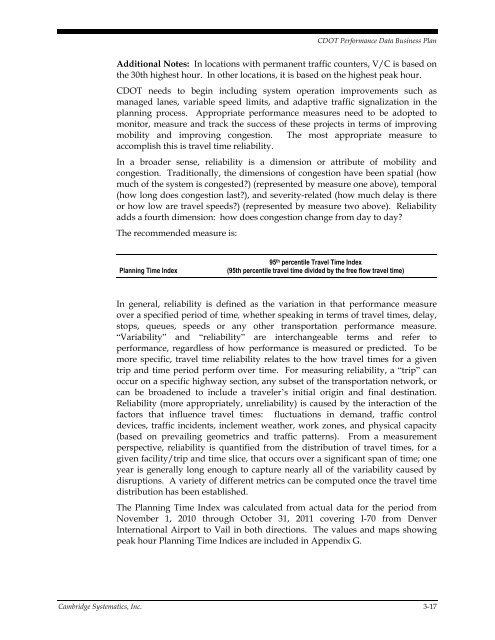CDOT Performance Data Business Plan - Cambridge Systematics
CDOT Performance Data Business Plan - Cambridge Systematics
CDOT Performance Data Business Plan - Cambridge Systematics
Create successful ePaper yourself
Turn your PDF publications into a flip-book with our unique Google optimized e-Paper software.
<strong>CDOT</strong> <strong>Performance</strong> <strong>Data</strong> <strong>Business</strong> <strong>Plan</strong><br />
Additional Notes: In locations with permanent traffic counters, V/C is based on<br />
the 30th highest hour. In other locations, it is based on the highest peak hour.<br />
<strong>CDOT</strong> needs to begin including system operation improvements such as<br />
managed lanes, variable speed limits, and adaptive traffic signalization in the<br />
planning process. Appropriate performance measures need to be adopted to<br />
monitor, measure and track the success of these projects in terms of improving<br />
mobility and improving congestion. The most appropriate measure to<br />
accomplish this is travel time reliability.<br />
In a broader sense, reliability is a dimension or attribute of mobility and<br />
congestion. Traditionally, the dimensions of congestion have been spatial (how<br />
much of the system is congested?) (represented by measure one above), temporal<br />
(how long does congestion last?), and severity-related (how much delay is there<br />
or how low are travel speeds?) (represented by measure two above). Reliability<br />
adds a fourth dimension: how does congestion change from day to day?<br />
The recommended measure is:<br />
<strong>Plan</strong>ning Time Index<br />
95 th percentile Travel Time Index<br />
(95th percentile travel time divided by the free flow travel time)<br />
In general, reliability is defined as the variation in that performance measure<br />
over a specified period of time, whether speaking in terms of travel times, delay,<br />
stops, queues, speeds or any other transportation performance measure.<br />
“Variability” and “reliability” are interchangeable terms and refer to<br />
performance, regardless of how performance is measured or predicted. To be<br />
more specific, travel time reliability relates to the how travel times for a given<br />
trip and time period perform over time. For measuring reliability, a “trip” can<br />
occur on a specific highway section, any subset of the transportation network, or<br />
can be broadened to include a traveler’s initial origin and final destination.<br />
Reliability (more appropriately, unreliability) is caused by the interaction of the<br />
factors that influence travel times: fluctuations in demand, traffic control<br />
devices, traffic incidents, inclement weather, work zones, and physical capacity<br />
(based on prevailing geometrics and traffic patterns). From a measurement<br />
perspective, reliability is quantified from the distribution of travel times, for a<br />
given facility/trip and time slice, that occurs over a significant span of time; one<br />
year is generally long enough to capture nearly all of the variability caused by<br />
disruptions. A variety of different metrics can be computed once the travel time<br />
distribution has been established.<br />
The <strong>Plan</strong>ning Time Index was calculated from actual data for the period from<br />
November 1, 2010 through October 31, 2011 covering I-70 from Denver<br />
International Airport to Vail in both directions. The values and maps showing<br />
peak hour <strong>Plan</strong>ning Time Indices are included in Appendix G.<br />
<strong>Cambridge</strong> <strong>Systematics</strong>, Inc. 3-17

















